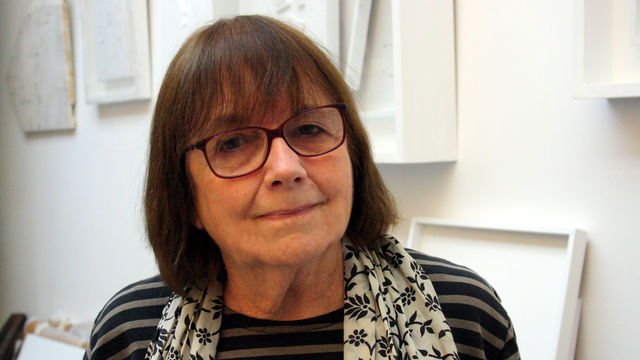
Marie Orensanz
Marí Nalte Orensanz was born in Mar del Plata, Argentina, in 1936. She added the letter e to her first name in 1972, when a gallery owner (who assumed she was a man) visited her studio and, after admiring her art, proceeded to tell her that the fact that she was a woman was detrimental to her work. This incident marked her awareness of gender bias in the art world. She trained with Emilio Pettoruti (1892–1971) from 1954 to 1958 and with Antonio Seguí (b. 1934) in the early 1960s. Her first solo exhibition took place in 1963, at Galería Rioboo, where she exhibited expressionist figurative paintings. That year she received her first award: the Premio Pio Collivadino y Amalia Brisolin de Collivadino. In 1964 she lived briefly in Paris, where she showed at the 80th Salon de l'Union des Femmes Peintres, Sculpteurs, Graveurs et Décorateurs at the Musée d'Art Moderne de la Ville de Paris.
Back in Buenos Aires and toward the end of the 1960s, she transitioned from what became known in Argentina as nueva figuración to three-dimensional abstract structures and spatial studies on white canvases evocative of the chaos in the city. This marked her first forays into geometry, mathematics, and philosophy, which in the 1970s developed into conceptual investigations. Notable during the early half of the 1970s is her participation in the group exhibition Arte de sistemas, organized by Jorge Glusberg for the Centro de Arte y Comunicación. In 1974, two years after moving with her family to Italy, she abandoned painting on canvas in favor of working in Carrara marble. At an exhibition in Milan titled Eros as Language (1974), Orensanz hung a manifesto in which she wrote "Il pensare èun fatto rivoluzionario" (Thinking is a revolutionary act), which heralded what would become a seminal phrase in her art (in 2004 she turned the phrase into a monument to the victims of the dictatorship, erected in the Parque de la Memoria in Buenos Aires).
In 1975 she settled with her family permanently in Paris and began developing the theory of fragmentism—intimately tied to her work with pieces of white marble—which she ultimately defined in a manifesto written in 1978. Her rigorous investigation of thought and matter marks Orensanz's prolific oeuvre. Her work is in museum collections around the world, including the Centre Pompidou in Paris and Museo Nacional de Bellas Artes in Buenos Aires.
—Marcela Guerrero
Selected Solo Exhibitions
1971 Marí Orensanz: Pinturas, Art Gallery International, Buenos Aires
1982 Marie Orensanz: "Fragmentismo"; Marbres, dessins, peintures, Galeries des Femmes, Paris
1999 Camino de artista, Museo de Arte Moderno de Buenos Aires
2003 Marie Orensanz: Variaciones sobre un mismo tema, Museo Municipal de Bellas Artes Juan B. Castagnino, Rosario, Argentina
2007 Marie Orensanz: Obras, 1963–2007, Museo de Arte Moderno de Buenos Aires
Selected Bibliography
Buccellato, Laura. Marie Orensanz: Obras, 1963–2007. Buenos Aires: Museo de Arte Moderno, 2007.
Una conversazione: Lea Vergine, Marie Orensanz, Gillo Dorfles. Milan: Galleria Vinciana, 1975.
Frérot, Christine. "Marie Orensanz: Aesthetic Thinking." ArtNexus, no. 59 (2005): 74–79.
———. Tout ce qui se voit et tout ce qui est caché, Marie Orensanz. Montreuil-sous-Bois, France: Lienart, 2010.
Marie Orensanz: "Fragmentismus," Arbeiten auf Marmor und Photographie, 27.9.–10.11.1985. Schallstadt-Wolfenweiler, Germany: Galerie Ruta Correa, 1985.


